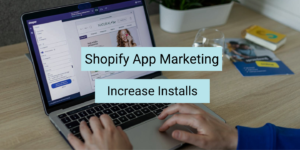Content marketing has become the gold standard for any SaaS marketing strategy. It builds brand authority, helps you connect with your target audience, and drives results throughout the customer’s journey.
High-quality content marketing can generate a whopping ROI of 448% for SaaS brands.
Content marketing has become an integral part of growth strategy in SaaS companies, and it’s no different for Shopify apps.
With the rise of mobile shopping, e-commerce, and smart technologies, merchants must make informed purchase decisions about the apps they use on their store. But with so many apps and tools trying to reach out to the same stores to offer different solutions, it can all be very confusing.
In the previous post, I shared all the marketing tactics you can use for a Shopify app; so now let’s deep dive into content marketing for Shopify apps.
Why should Shopify apps care about content marketing?
Content marketing is a powerful tool for Shopify apps to support overall marketing efforts and further increase user acquisition, engagement, and retention, ultimately leading to increased revenue and business growth. Here are a few ways content marketing can help Shopify apps:
1. Increases visibility and traffic
Content like blog posts, videos, and social media content can help drive organic traffic to your Shopify app’s website or landing pages. When the prospects search for relevant information or solutions related to your app, high-quality content can help your app rank high in the search engine results, increasing traffic and visibility.
2. Builds credibility and trust
High-quality content establishes your app as an authority in your niche. Providing invaluable and helpful content builds trust among your target audience, which translates into increased user confidence and more app installations.
3. Lead generation
Content marketing can be a robust and powerful tool for lead generation. Shopify apps can expand their email lists by offering valuable resources like e-books, webinars, or whitepapers in exchange for contact information and nurturing leads through the sales funnel.
4. Supports SEO Efforts
Content marketing is a critical component of SEO. Publishing relevant and exceptional content regularly can improve your app’s rankings in search engines, making it easier for potential users to discover you. That way you don’t have to rely on the Shopify App Store listing alone – which you have no control over.
5. Reduces Customer Acquisition Cost (CAC)
Content marketing reduces CAC by attracting organic traffic through valuable content. When potential users discover your app through informative blog posts or social media content, they’re more likely to convert, resulting in a lower CAC than paid advertising methods.
6. Obtain data and insights
Content marketing can provide valuable insights into your audience’s preferences, interests, and pain points. You can make data-driven, informed decisions to enhance your app and marketing strategies by analyzing user interactions with your content.
7. Increases customer retention
Content marketing isn’t just for acquiring new consumers and retaining existing ones. Regularly updated blogs, email newsletters, and knowledge bases can keep current users engaged, informed and less likely to churn.
How can Shopify Apps use Content Marketing?
Shopify apps can use content marketing to attract and engage their audience, build trust, and drive more installations and conversions. Here are some strategies that can be employed to leverage content marketing effectively:
1. Build out a site
Building a content site that complements your Shopify app can aid in establishing your brand’s niche as an authority while driving more traffic and conversions. However, it is crucial to maintain a consistent brand image to ensure that your site serves as a helpful resource for your users.
- Create a user-friendly design that makes the site visually appealing, helps integrate Shopify products seamlessly, and optimizes for SEO.
- Build pages based on specific goals, subtly plugging their product features across.
- Organize your content into topics or categories relevant to your app’s niche, making it easy for visitors to find the information they want.
- Implement lead capture forms, pop-ups, or CTAs on your content site to collect email addresses.
- Use analytics tools to track user behavior, website traffic, and content performance.
- Make it seamless for users to browse and purchase products related to the content by ensuring a smooth transition from your content site to your Shopify app.
Here’s how Recart classified its resource library by efficiently categorizing the type of content a reader would ideally search for, based on the buyer journey.

2. Create a blog
Start a blog on your Shopify app’s website or a dedicated blog site. Publish high-quality, informative, and relevant content that addresses the challenges and pain points your target audiences face. For example, if your app is related to e-commerce SEO, you could write articles about optimizing product listings or improving website speed. It educates your audience and also leads them to the “a-ha moment” that they need your services.
Klaviyo is an email and SMS marketing tool designed for Shopify brands across the world. Their blog gives readers all the relevant information about email marketing and how Shopify apps can use their platform to promote their businesses.
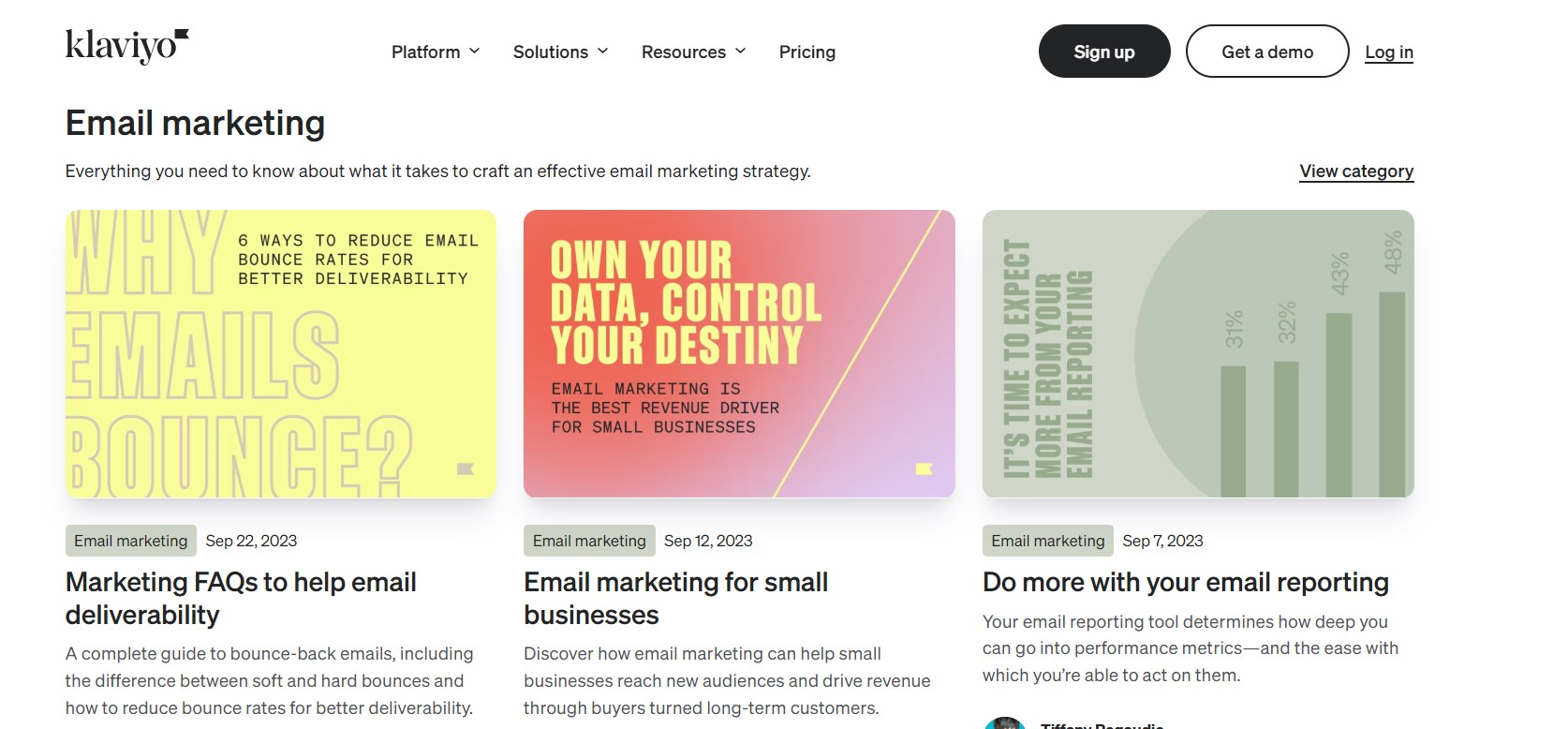
3. Create case studies
Identify satisfied customers willing to share their success stories and craft compelling narratives detailing how the app helped solve specific problems or achieve results. Use real-time data and testimonials to add credibility by showcasing before-and-after scenarios and quantifying the benefits.
Presenting real-world successes builds trust and proves the app’s value and efficiency to the prospects. Even Shopify publishes active case studies to showcase their CMS features in a better light, as brands relate to brands and get inspired by them.
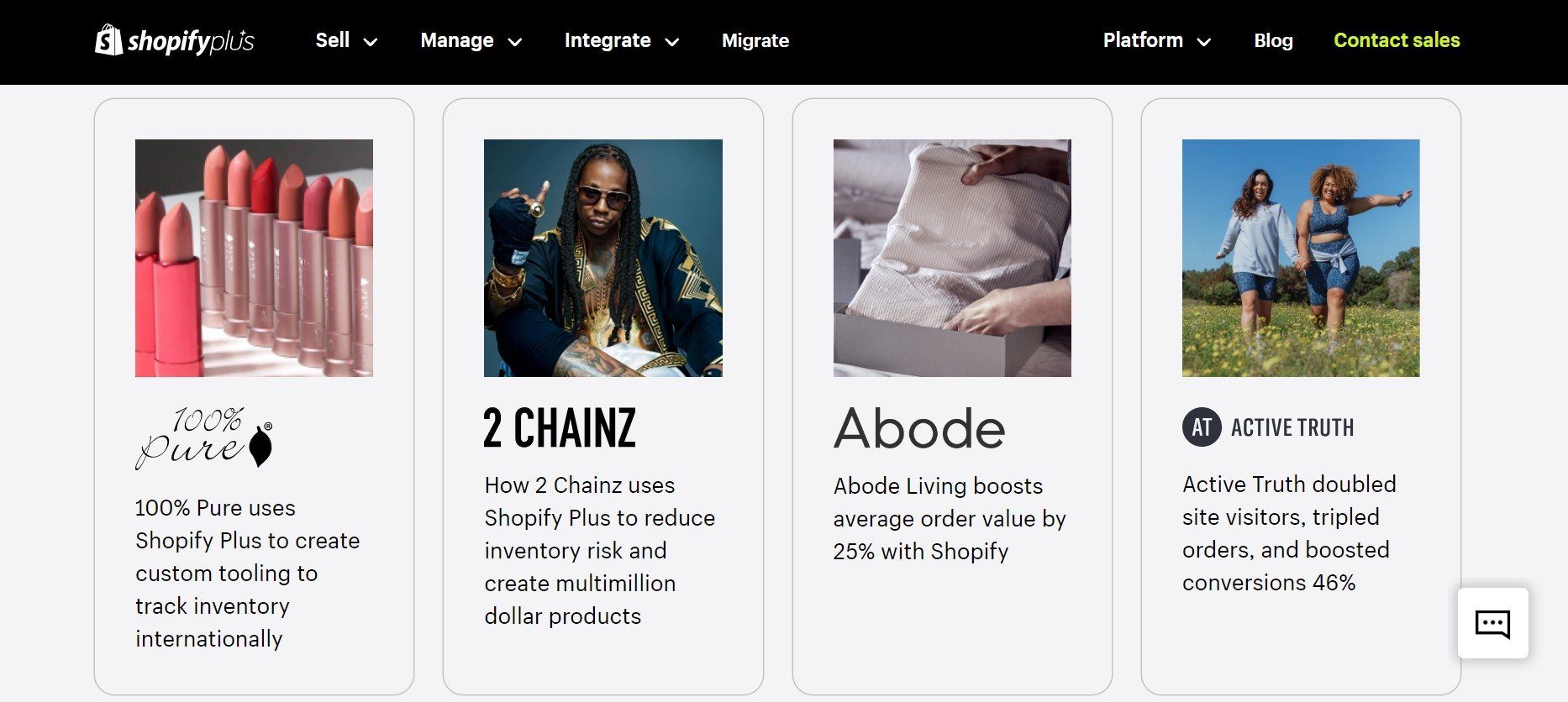
4. Create how-to guides
Develop educational content such as how-to guides, tutorials, and step-by-step instructions on using your app effectively. This content should showcase your app’s value and help users get the most out of it. These guides should offer valuable information, tips, and solutions related to their target audience’s interests or pain points, aligning with their products or services.
Omnisend does a great job of this by adding eye-catching visuals in their guide instead of plainly quoting stats from reports.
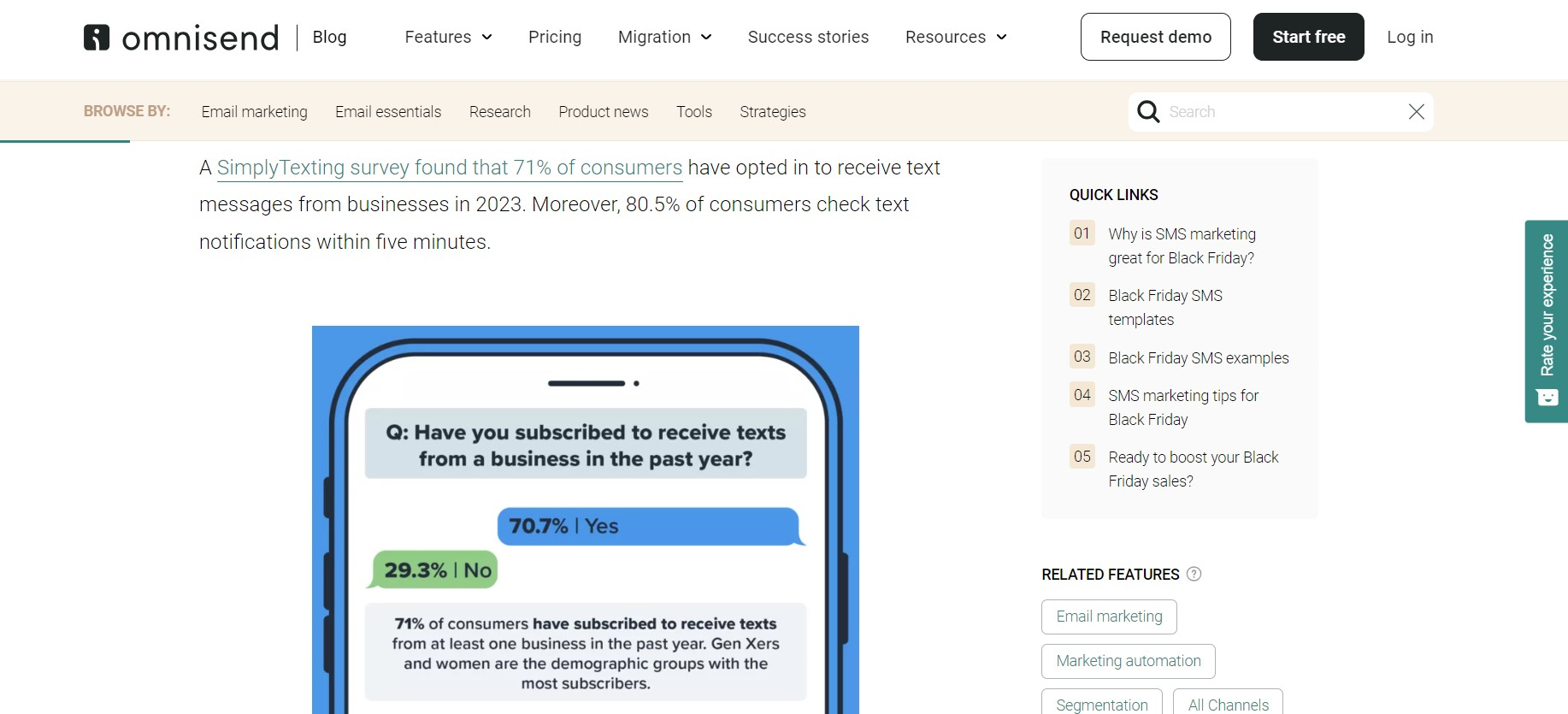
5. Optimize help documents
Help docs provide valuable assistance to users and contribute to content marketing efforts by attracting, engaging, and retaining customers. Create help docs that address common user queries and pain points. Implement a search feature within your help doc to enable users to find answers faster. Ensure that the help docs are responsive by updating them with any changes to your app.
The Judge.me support page presents a very simple layout where users can get their queries answered, along with providing options for multiple languages. The goal is to ensure you provide clear answers to users’ queries quickly instead of making them surf your website for hours trying to find a solution.
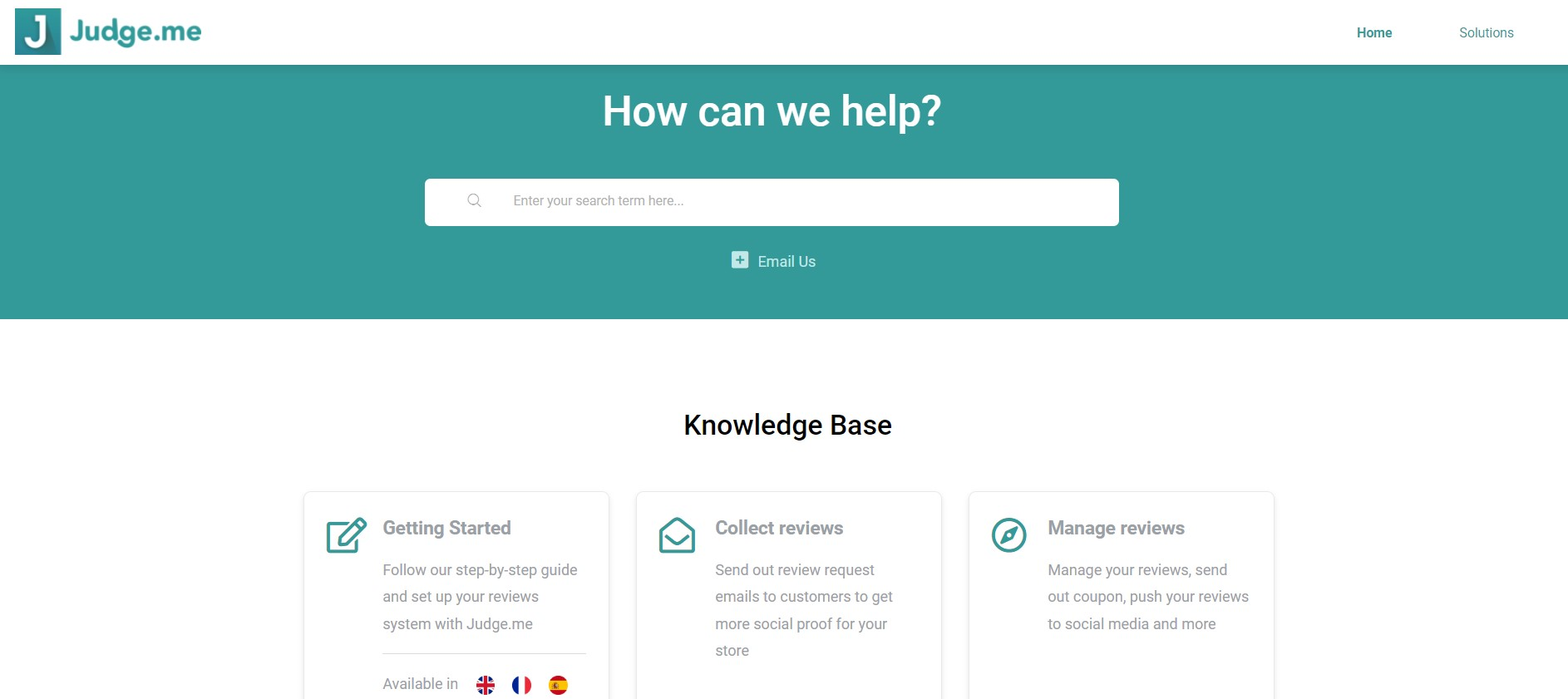
6. Create industry-wise pages
Shopify apps can capitalize on content marketing by creating industry-specific pages. Focus on curating content that addresses each industry’s unique needs and pain points. Craft informative blog posts, guides, and case studies tailored to those niches, and optimize these pages with industry-relevant keywords to boost SEO.
For instance, Quickreply.ai has multiple use cases for its product, which is showcased on its toolbar.
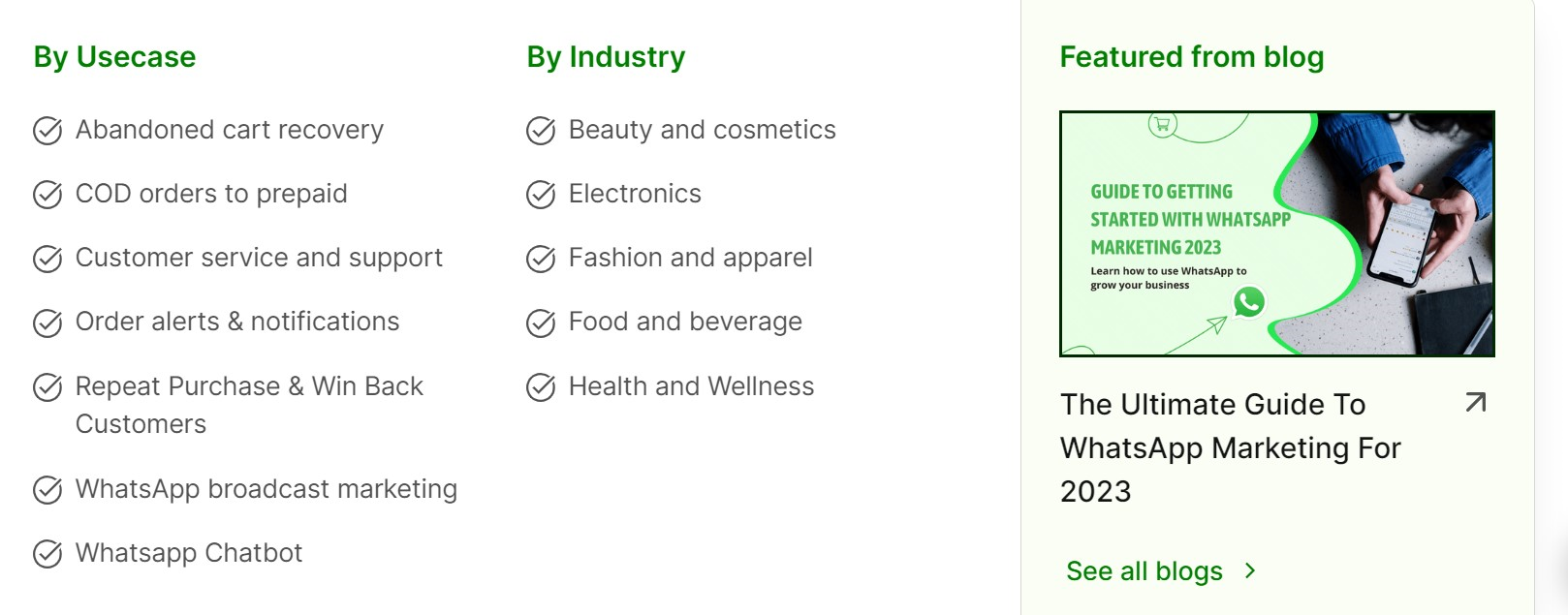
Not to mention, each use case and industry has its own individual landing page, so users can fairly evaluate the tool as per their requirements.
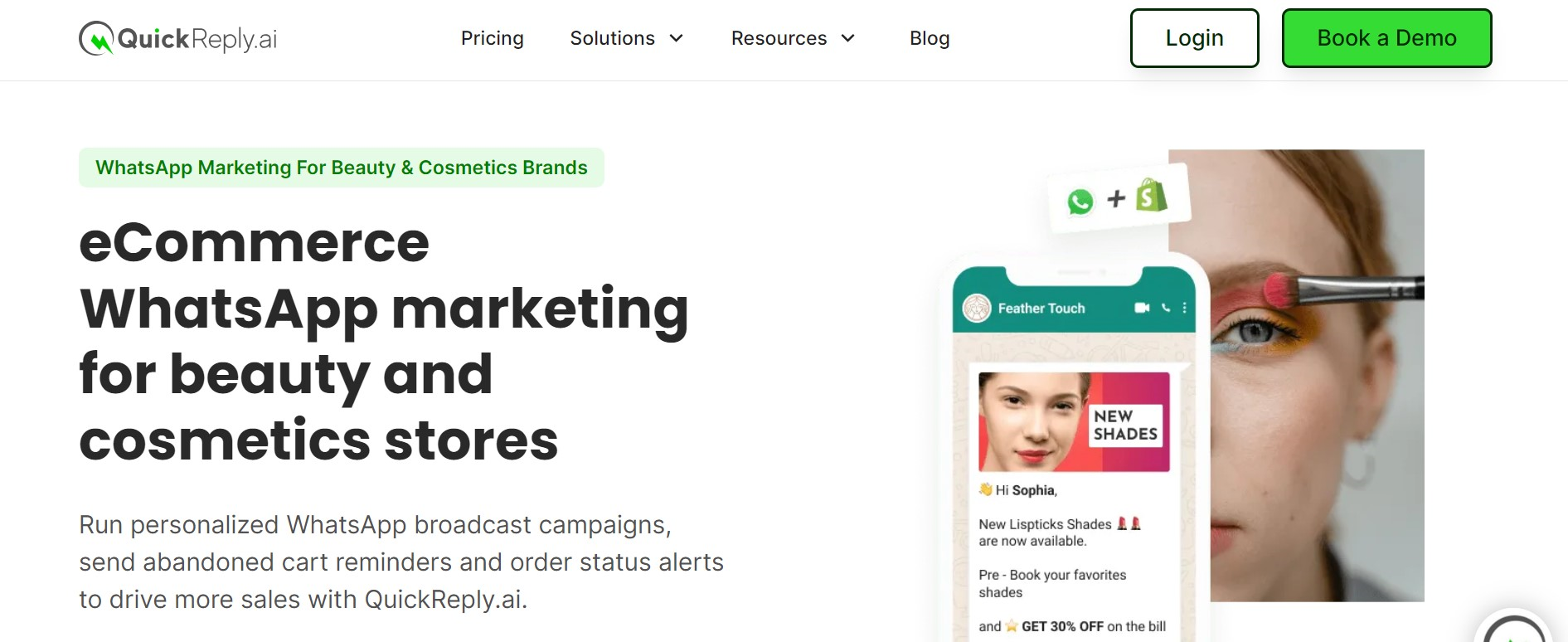
7. Create listicles
Listicles can capture readers’ attention, provide valuable information, and drive traffic to your Shopify app. Creating engaging, in-depth, informative listicle content can enhance your content marketing efforts and attract and retain a wider audience. You can leverage content marketing by creating listicles that offer quick, actionable insight.
However, a listicle simply doesn’t always imply writing “X Best Tools” style blogs. Craft lists related to industry trends, app features, or problem-solving tips. Use engaging headlines to pique interest, and keep lists concise and scannable.
A great example would be Shopney’s listicle on push notification ideas. The headline instantly grabs the reader’s attention by sharing how they can reach a favorable outcome of boosting engagement rate on their mobile app.
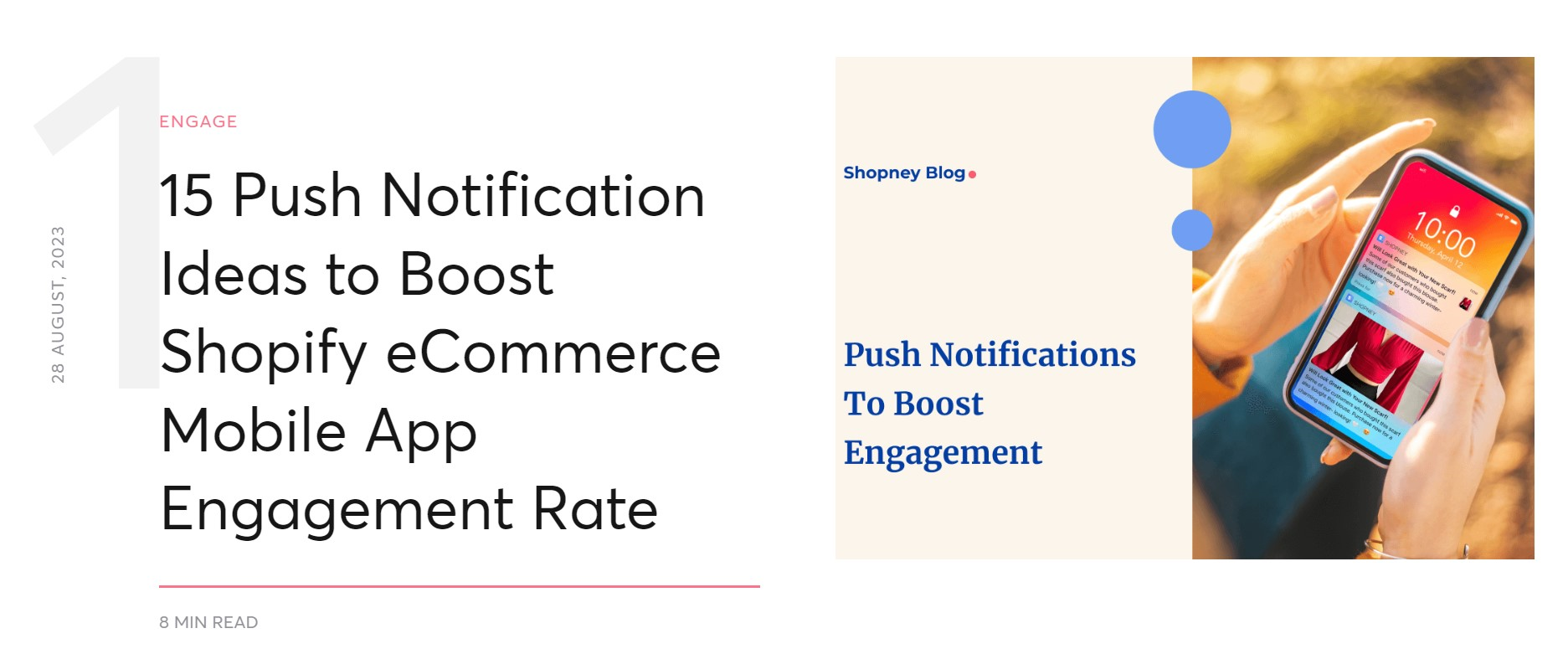
8. Develop engaging templates
Providing valuable, customizable templates and educating users on their benefits can help attract, engage, and retain customers while proving their app’s practicality and versatility. Develop a range of templates for different e-commerce needs, such as product pages, email marketing, invoices, etc.
Quickreply.ai offers a wide range of Whatsapp templates based on different events in a year so you can customize your messaging to your customers based on the occasion.
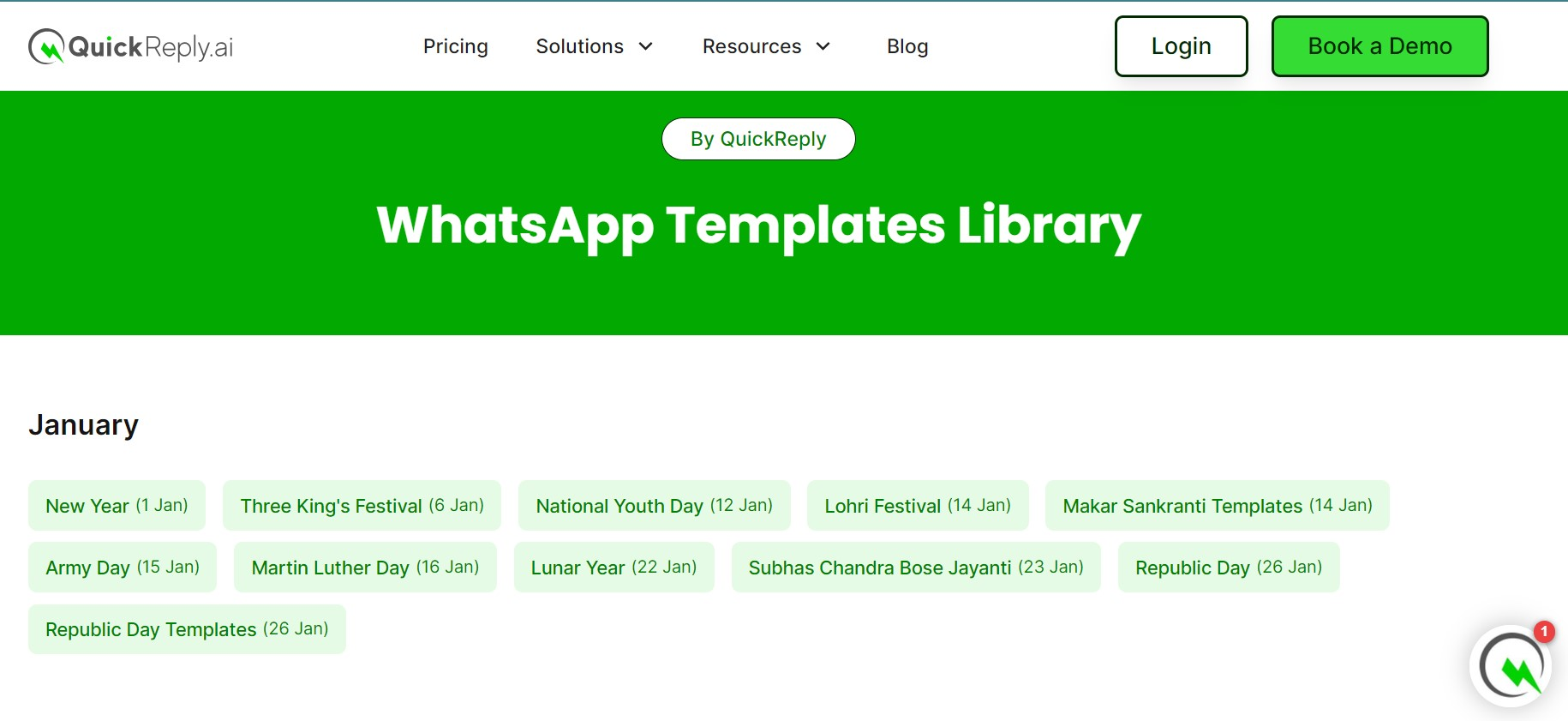
Offering free and premium templates allows users to sample the quality before committing. Encourage users to provide feedback on templates, allowing you to refine and expand your offerings.
9. Build an academy
Create in-depth courses, tutorials, and guides about your app’s features and benefits. Incorporate quizzes, assignments, and interactive elements to engage users and test their knowledge. Offer certifications or badges upon course completion, motivating users to engage with your content.
Interakt has a wide range of courses, tutorials and articles on their website that can help a reader learn how businesses can leverage WhatsApp for growth.
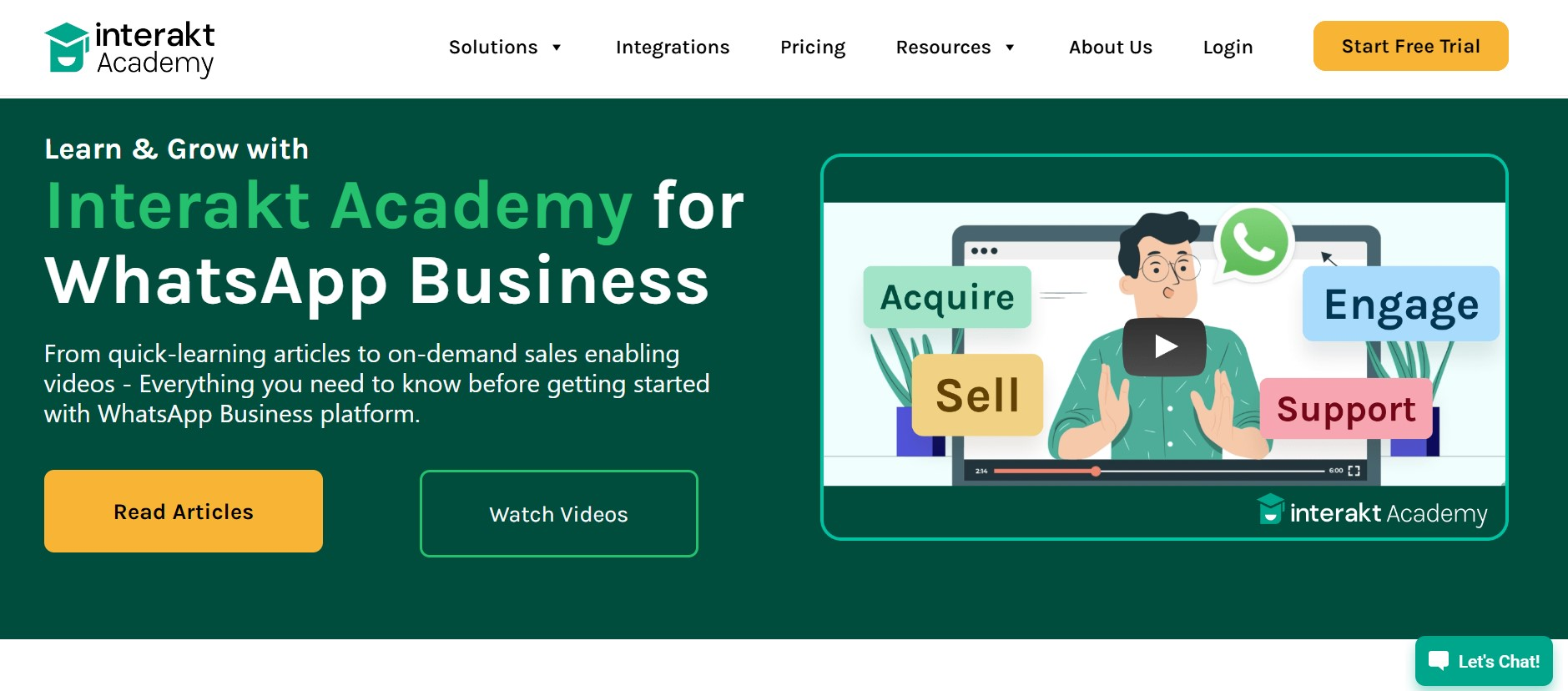
Encourage discussion and networking among users within the academy, fostering a sense of community. Promote the academy through your app’s website, email newsletters, and social media channels. Ensure seamless integration between the academy and your app, allowing users to directly apply what they’ve learned.
How can Shopify apps get started with content marketing?
Don’t just begin with content marketing; here’s how to approach the tactic to get the best of results:
1. Identify your target audience
To kick-start content marketing, Shopify apps should first identify their target audience. Start by defining the size of the businesses they want to target and segmenting prospects based on criteria like annual revenue, employee count, or online store traffic. Consider the scalability of your app and align it with the needs and resources of businesses in various size brackets, such as small, medium, or enterprise.
Test your content consistently with different segments and gather user feedback to refine your targeting and messaging.
By defining the size of the businesses you want to target, you can customize your content marketing efforts effectively, ensuring that your content aligns with the requirements and goals of your target audience within each size category.
2. Identify your value proposition
Identify what sets your app apart from competitors. Highlight key benefits, features, or advantages that solve specific problems for online businesses. Communicate how using your app can save time, increase sales, or enhance efficiency.
Emphasize how your app can help simplify communication and boost conversions, retention, and sales. Your value proposition should resonate with your target users and form the foundation of your content strategy, effectively conveying why users should choose your app.
3. Identify competitors
As of today, there are about 4,000 Shopify apps; hence, there is a lot of competition, no matter what your app is built for.
For instance, if you type ‘Shopify loyalty app,’ you will find at least 4-5 apps, so it is vital to see who you are competing with. By gathering data from various sources, Shopify apps can help you understand your competitive landscape and refine your content marketing strategy.
You can identify market trends, gaps, and opportunities by analyzing this data. You can use this data to create targeted content, optimize SEO strategies, and customize marketing campaigns to attract prospects interested in similar products or services. Eventually, identifying competitors helps businesses stay competitive and boost their content marketing efforts.
4. Run a competitor analysis and gap analysis
Perform a comprehensive competitor and gap analysis by identifying key competitors in your niche by analyzing their content, SEO strategies, social media presence, and product offerings. You must also assess competitors’ keyword rankings, backlink profiles, and social engagement, highlighting areas where they excel.
Gap analysis identifies content, product, or marketing opportunities where competitors are weak or absent.
Businesses can develop a content marketing strategy by using this data to fill these gaps, tailor content to their audience’s preferences, attract a wider audience, and achieve a competitive edge in the Shopify ecosystem.
5. Conduct keyword analysis
Before you hunt for keywords, you must understand your audience thoroughly. What are their challenges? What kind of products or services are they looking for? What language do they use when describing their pain points and requirements?
Start by identifying the primary keywords related to your Shopify app. I recommend shortlisting 25 keywords for each of the pillars you establish.
Analyze the keywords that your competitors or similar apps are targeting. Look for more specific long-tail keywords, like “Shopify app for email marketing automation” or “best Shopify app for product recommendations.”
Consider the intent behind the keywords. Are users looking for solutions, reviews, or comparisons? Tailor your content to match user intent. Keyword analysis is an ongoing process requiring regular updates and adjustments with changes in user search behavior, trends, and competition.
6. Create a content calendar
Creating a content calendar for Shopify apps’ content marketing involves careful planning and organization. The first thing to do is to determine your content marketing objectives. Are you looking to enhance brand awareness, drive traffic, boost user engagement, or generate leads?
Once you have a clear goal in mind, work on the following:
- Consider user preferences and pain points and finalize content formats (blog posts, videos, etc.).
- Align with the app’s value proposition and audience needs.
- Create a content publishing schedule.
- Assign content creation and promotion tasks.
- Plan for content repurposing.
- Set key metrics to measure success.
- Review and adjust the content calendar.
Wrapping it up
While many SaaS companies have recognized the potential of content marketing for customer acquisition and retention, Shopify apps are yet to enter the arena.
Content marketing offers a substantial opportunity for Shopify apps to distinguish themselves, provide value, and build brand loyalty. Shopify app developers should consider a more proactive and comprehensive approach to content marketing in today’s dynamic digital environment to stay relevant and competitive.
Feel free to reach out to me or my team at Contensify if you need any help with Shopify app content marketing.


